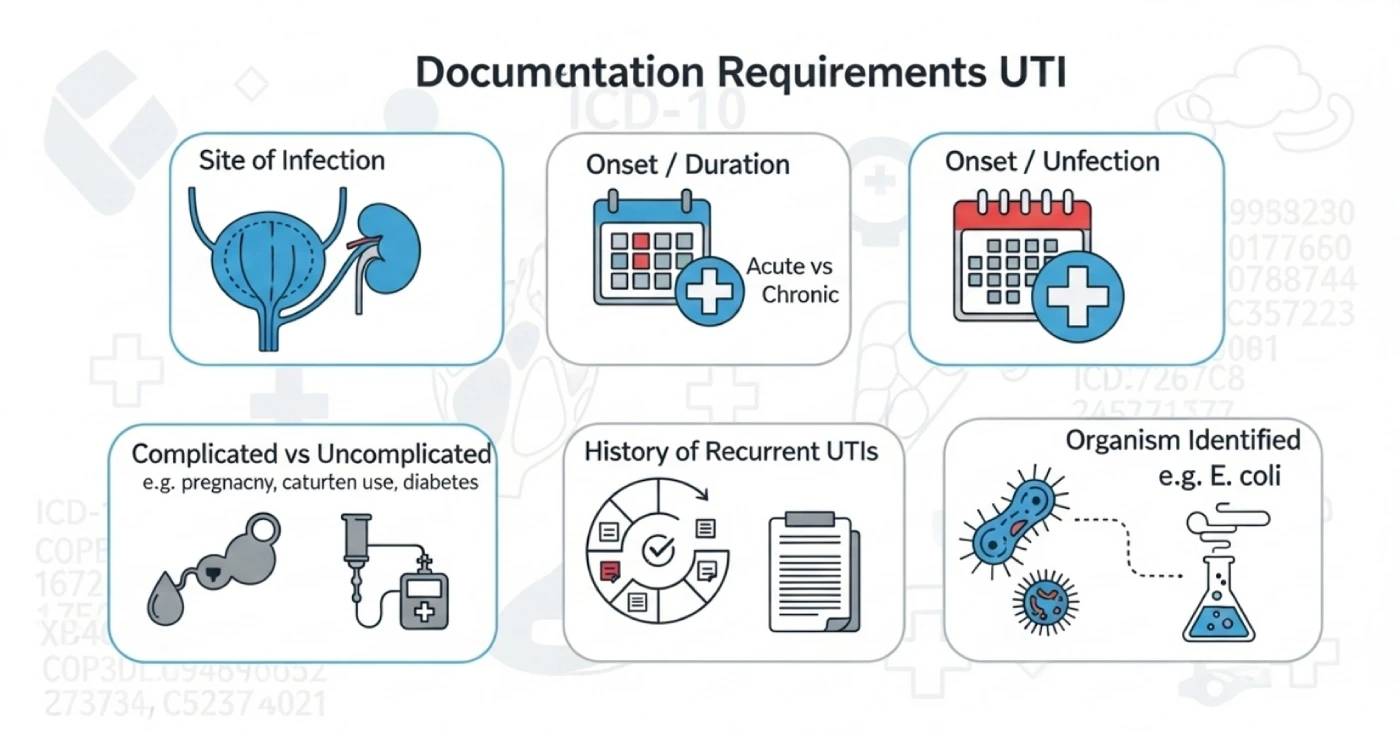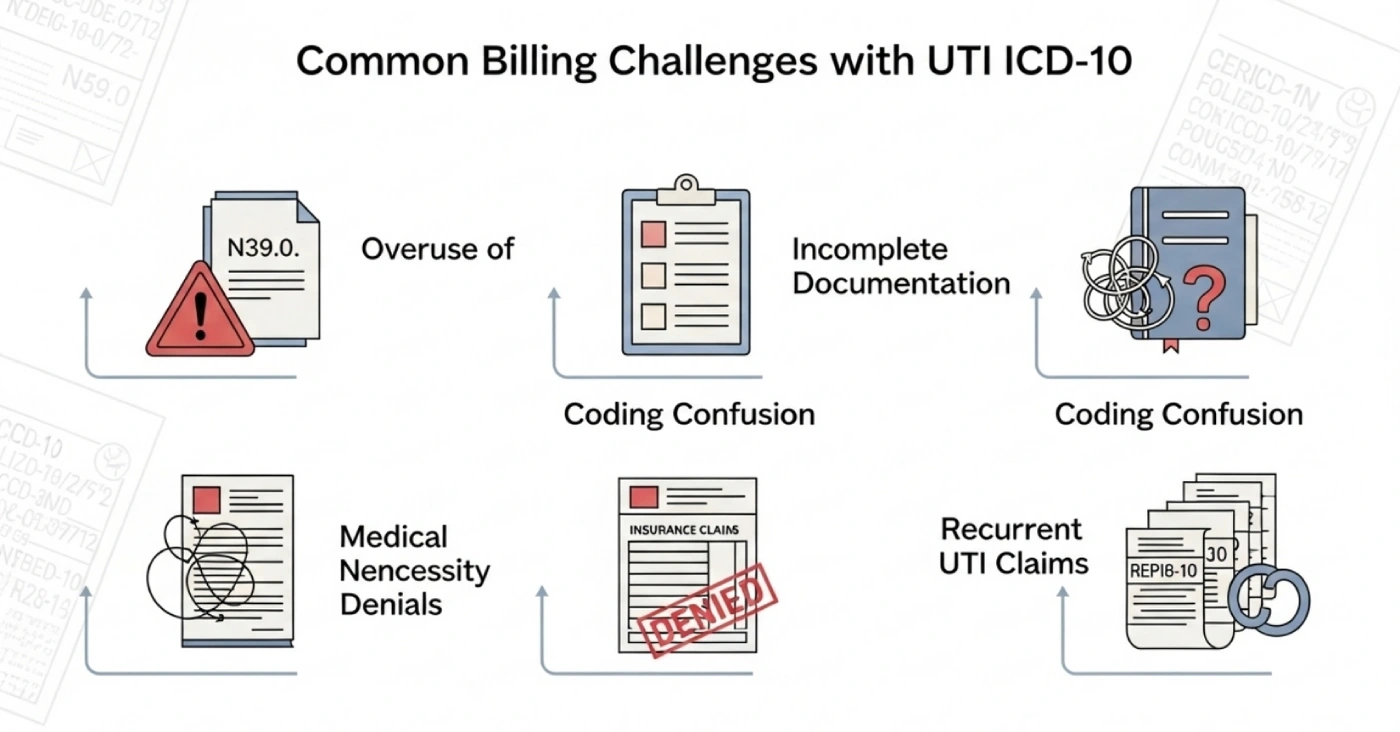According to the PubMed Central report, UTIs are among the most common infections that are diagnosed in the United States. Approximately 50–60% of women will experience at least one UTI in their lifetime. While less common, UTIs also affect men, with at least 12% experiencing a UTI in their lifetime. Medically, UTIs are a high-volume condition that has to be coded correctly under the ICD-10 code, properly documented, and cautiously aligned with payer requirements to achieve on-time reimbursement.
ICD-10 code of urinary tract infection (N39.0) is very common, but coders should also be familiar with the corresponding site-specific code, documentation requirements, and billing processes. Mistakes within this process are likely to result in the rejection of a claim, the risk of non-compliance, and the payments.
This guide provides a closer examination of ICD-10 codes of UTIs including documentation, recurrent UTIs, billing issues, and the role of medical billing and credentialing services, and how expert help from Hello MDs can streamline your revenue cycle.
A urinary tract infection is an infection that presents in any part of the urinary system, from the kidney to the urethra. It occurs when different harmful bacteria invade the urinary system, which includes:
Most UTIs are caused by Escherichia coli (E. coli), though other bacteria or fungi may also be responsible. From a coding perspective, the important thing is differentiating where the infection is and whether it is acute, chronic or recurrent
For coding and billing, it is important to note whether the infection is uncomplicated (bladder only) or complicated (spread to the kidneys, associated with comorbidities, or recurrent).
A critical coding change for 2025: N39.0 now carries an Excludes1 note that prohibits its use when the infection site is documented.
Implications:
This update demands stricter documentation and coding discipline to avoid claim denials.
When coders can’t determine the specific infection site, they’d default to:
N39.0 – Urinary tract infection, site not specified
However, using N39.0 is risky. Payers are increasingly strict about ambiguity, and generic codes are more prone to denials or audits. Use this only when the provider’s documentation truly lacks clarity.
Here are frequently used ICD-10 codes for urinary tract infections and related conditions:
ICD‑10 Code | Condition / Description |
N30.0 | Acute cystitis (bladder) |
N30.9 | Cystitis, unspecified |
N10 | Acute pyelonephritis (kidney) |
N11 | Chronic pyelonephritis |
R82.71 | Asymptomatic bacteriuria |
B96.20 | E. coli as cause of disease classified elsewhere (when identified) |
Z87.440 | Personal history of urinary tract infection (for recurrent cases) |
Examples:
“Acute pyelonephritis due to E. coli” → use N10 + B96.20, not N39.0
A patient with multiple UTI episodes → N39.0 with Z87.440
Selecting the right code is crucial to avoid claim rejections. For expert assistance, consider partnering with Hello MD’s Medical Coding Services to ensure precise coding aligned with payer rules.
Note: Leukocytosis often appears in infections such as UTIs. For tips on accurately coding infection-related conditions, check out our blog to understand the ICD-10 code for Leukocytosis.
Accurate documentation is the backbone of medical billing. For UTIs, coders rely on provider notes that clearly describe:
Without those details, coders are forced to resort to N39.0, which is less defensible to payers under the Excludes 1 rule. The patients who are suffering from acute pyelonephritis are due to E.coli.

In billing, you must ensure your CPT codes align with your ICD-10 diagnosis codes so payers accept the medical necessity. A mismatch is a common reason for denials.
Always verify each payer’s clinical validation/claim review guidelines before submission. Billing teams should verify payer rules before claim submission to minimise rejections.
Despite being straightforward, UTI claims face frequent billing challenges. These include:
These challenges highlight the need for trained coders and strong provider–billing communication.

Providers and billing specialists can reduce claim errors with these strategies:
Outsource professional billing/credentialing services to gain knowledge and conformance.
Credentialing may not seem directly tied to UTI billing, but it plays a key role in ensuring providers can submit claims to payers. Without proper credentialing:
Credentialing ensures providers are enrolled with insurance networks, enabling smooth claim submission and timely payment. Learn more about our Credentialing & Enrollment services designed to keep your practice in-network and claims flowing smoothly.
Outsourcing billing and credentialing, like Hello MDs, provides several benefits:
By relying on experienced billing partners, healthcare organizations free up staff time while ensuring compliance and financial stability.
For accurate billing, the proper ICD-10 coding for UTIs is so important. Accurate documents will increase reimbursement and also reduce the chances of claim denials. If you are using unspecified code like N39.0 without any detailed documentation will increase your audit risk. Always see where the infection is present and also see the related factors like recurrence or complications. To ensure your compliance, always align ICD-10 codes with CPT codes and payer policies.
Partnering with expert billing and credentialing services like Hello MDs helps streamline your revenue cycle, reduce errors, and optimize cash flow. For efficient ICD-10 UTI coding and billing, rely on experienced professionals who understand payer-specific requirements and documentation best practices.
Disclaimer:
The information provided here is intended for educational purposes only. For specific coding or billing decisions, consult a certified professional or official ICD-10 resources.
The first code is N39.0 -Urinary tract infection, site not specified. Clinical details should be used to determine the location of the infection, at which specific codes must be used.
N39.0 is a UTI with no reported site, such as bladder or kidney. Coders will use detailed medical records to choose more specific codes that they can use to ensure proper billing.
Treat with N39.0 with evident mentation of the recurrent nature of the infection. Include Z87.440 (personal history of UTI) to substantiate the cases of repeated episodes.
N10 is applied in acute pyelonephritis, which is a severe kidney infection. Firm up with such symptoms as fever or flank pain, and diagnostic test results.
Unspecified codes can be denied because of imprecise documentation or those that are overutilized. Rejections also occur due to the absence of test results or ambiguity in medical necessity.
Location, symptoms, and test results of UTI, such as urinalysis or culture. Adhere to ICD-10-CM and document any complicating factors to approve the claim.